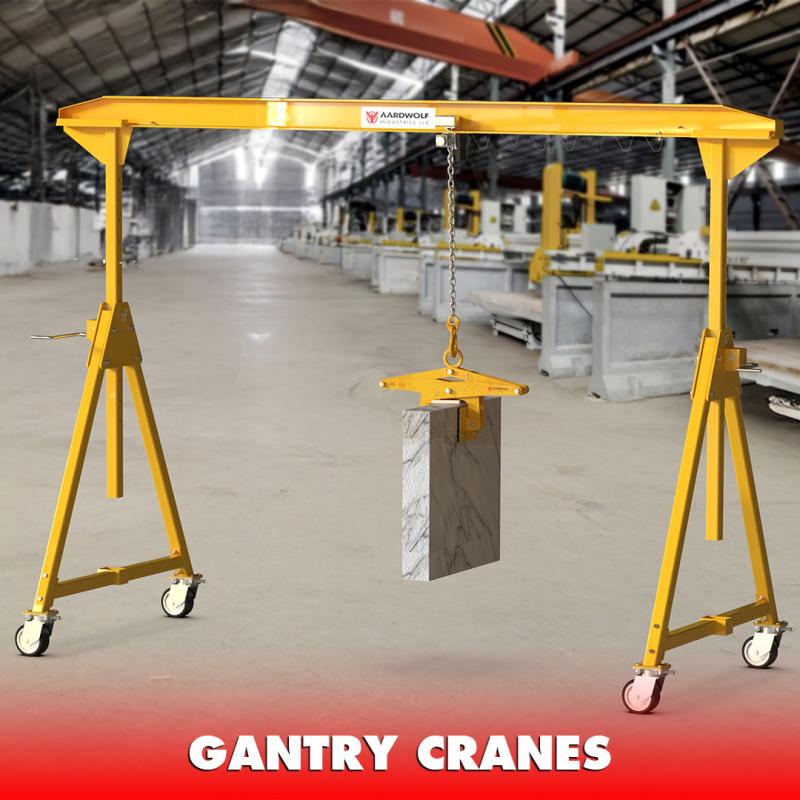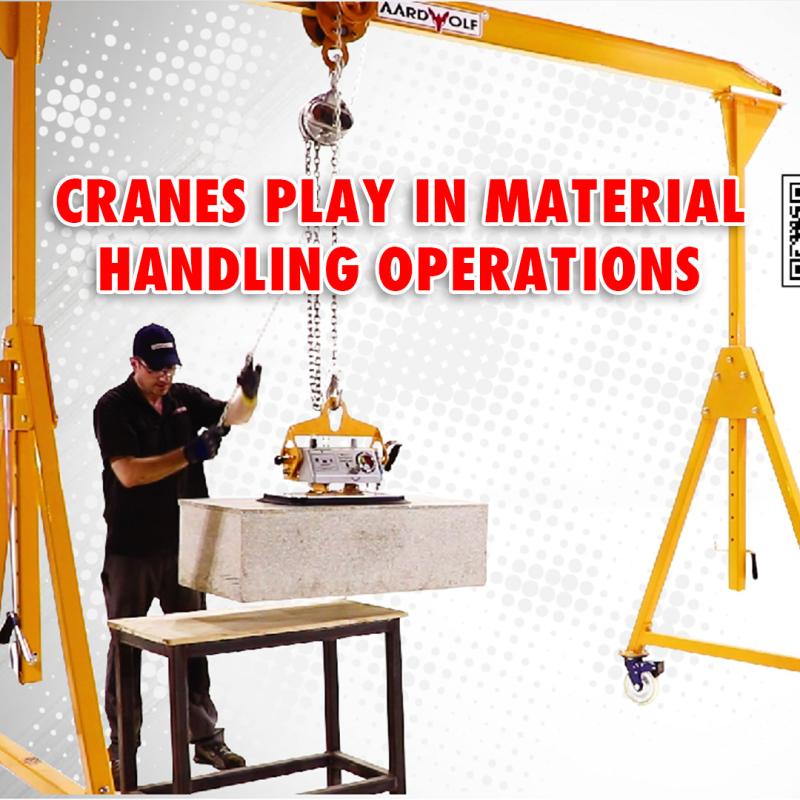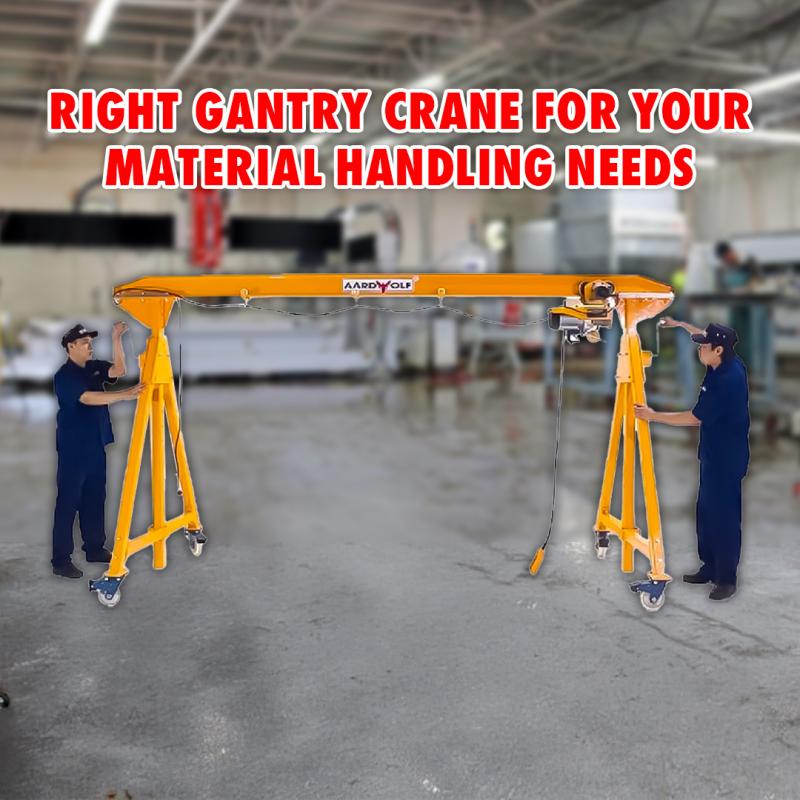



Used across industries such as manufacturing, construction, and logistics, gantry cranes offer versatility and efficiency for lifting tasks where overhead cranes may not be feasible.
In this guide, you’ll learn what a gantry crane is, its types, how it’s made, industrial applications, and the benefits that make it an essential tool in modern operations.
Understanding the Gantry Crane
A gantry crane consists of a horizontal beam supported by freestanding vertical legs. The beam holds a trolley and hoist that travel along its length, allowing loads to be lifted and transported.
Unlike bridge cranes, gantry cranes are not fixed to a building structure. This makes them ideal for outdoor use or in facilities where installation of overhead cranes is impractical.
Key Features of a Gantry Crane
A horizontal bridge (girder) for trolley movement
Freestanding legs that support the structure
A trolley and hoist mechanism for lifting
Power and control systems for movement and operation
Types of Gantry Cranes
Gantry cranes come in a wide variety of types, each designed for specific environments, load capacities, and operational requirements.
Full Gantry Crane
This is the most common type of heavy-duty gantry crane. It has two vertical legs that move on tracks or wheels, supporting a horizontal beam. Full gantry cranes are used in shipyards, steel yards, and large manufacturing plants.
Semi-Gantry Crane
A semi-gantry crane uses one leg while the other end is supported by a runway attached to a building wall. It’s perfect for facilities with space constraints, such as machine shops or industrial plants.
Portable Gantry Crane
Designed for mobility and temporary use, these cranes are lightweight and mounted on wheels or casters. They are ideal for workshops, garages, and maintenance tasks, typically handling loads up to 5 tons.
Adjustable Gantry Crane
These cranes offer adjustable height, span, and width. They’re highly versatile and can adapt to different job requirements, making them useful in dynamic work environments.
Single Girder Gantry Crane
This crane has one main girder and is used for light to moderate lifting needs. It is more economical and easier to install than double girder designs.
Double Girder Gantry Crane
Featuring two girders, this type provides higher lifting capacity, greater span, and more stability. It’s widely used in heavy industries like mining, shipbuilding, and steel production.
Truss Gantry Crane
Truss-style gantry cranes feature a lightweight frame that reduces wind resistance, making them ideal for outdoor applications like construction and material storage yards.
Box Gantry Crane
Box girder gantry cranes are known for strength and durability. The enclosed box structure increases rigidity, supporting extremely heavy loads over long spans.
L-Shaped Gantry Crane
With L-shaped support legs, these cranes are ideal for handling long items like steel beams or piping. The shape allows for increased clearance and improved maneuverability.
U-Shaped Gantry Crane
Designed to lift and move oversized or wide loads, the U-shaped structure offers enhanced lateral clearance. Commonly used in container handling and logistics.
Workstation Gantry Crane
Light-duty gantry cranes for assembly lines, repair shops, and labs. Their small size and mobility make them suitable for repetitive lifting tasks in confined areas.
How Gantry Cranes Are Built
The manufacturing process of gantry cranes involves careful engineering of mechanical, structural, and electrical components. Each system must be optimized for the crane’s load rating and intended use.
Structural Design
The frame includes girders and supporting legs made from high-grade steel. The structure may be an I-beam, box, or truss configuration, depending on load capacity and span.
Trolley and Hoist System
The trolley runs along the beam and carries the hoist. Hoists may be electric, pneumatic, or manual. Chain hoists are used for lighter loads, while wire rope hoists handle heavy-duty lifting.
Power and Controls
Gantry cranes are powered by electricity, with power fed through festoon systems, conductor bars, or cable reels. Control methods include:
Pendant control
Radio remote control
Driver cabins (for large cranes)
Advanced control systems may feature overload sensors, programmable logic controllers (PLCs), and variable frequency drives (VFDs) for better performance and safety.
Industrial Applications of Gantry Cranes
Gantry cranes serve a broad range of industries, offering unmatched flexibility and lifting capacity.
Manufacturing and Assembly
Used to lift engines, molds, components, and raw materials. Common in automotive, aerospace, and heavy machinery sectors.
Warehousing and Logistics
Support efficient material handling from unloading docks to storage zones. Portable cranes are especially useful in space-constrained warehouses.
Shipyards and Marine Terminals
Handle large components like ship engines and containers. Gantry cranes are indispensable in vessel construction and cargo handling.
Construction Sites
Lift heavy construction materials such as concrete slabs and steel beams. They can be quickly assembled and disassembled as projects progress.
Repair and Maintenance Facilities
Portable gantry cranes assist mechanics in lifting engines or heavy parts during servicing. Their mobility makes them ideal for confined shops.
Container Handling
Specialized gantry cranes stack and move shipping containers in ports and rail yards, enhancing speed and safety in freight logistics.
Gantry Crane Load Capacities
Choosing the right crane capacity is critical for safety and productivity. Common capacity tiers include:
1–2 tons: Light-duty use in workshops
5 tons: General maintenance and fabrication
10–15 tons: Assembly lines and mid-range lifting
20–30 tons: Construction and industrial processing
50+ tons: Heavy-duty operations in shipyards and ports
Always match the crane’s capacity to the weight and frequency of your lifting needs.
Aardwolf gantry cranes are designed for full mobility, equipped with high-quality swivel casters and lockable wheels. This makes them ideal for workshops, fabrication floors, and small manufacturing facilities where equipment frequently moves.
Example:
An AGC-1500 model can be quickly rolled between workstations in a stone processing plant for lifting and positioning granite slabs without using forklifts or permanent cranes.
Aardwolf’s adjustable gantry cranes allow height and beam length adjustment, providing flexibility in environments with limited space or varied lifting requirements.
Benefits include:
Easy clearance under doorways or ducting
Ability to lift different load sizes
Customizable for specific job sites
Example:
In a countertop fabrication shop, an AGC crane is adjusted to lift marble slabs inside a low-clearance warehouse, then raised again for use near cutting equipment.
Constructed from high-strength aluminum or steel, Aardwolf gantry cranes are built to be lightweight for maneuverability yet strong enough to lift loads up to 3 tons.
Benefits:
Easier handling and setup
Corrosion-resistant frames (especially important in wet or dusty environments)
Example:
The AGC-2000 model is used in a glass handling facility, where its aluminum frame resists moisture while lifting large glass panels with vacuum lifters.
All Aardwolf gantry cranes are designed for simple, tool-assisted assembly and disassembly, making them ideal for mobile teams or multi-site use.
Advantages:
Saves time during setup
Minimizes labor required
Compact disassembly for transportation
Example:
A construction crew uses the AGC-3000 to lift HVAC equipment on-site, then quickly disassembles it and transports it to the next job location.
Aardwolf gantry cranes integrate seamlessly with the company’s full range of lifting attachments, including:
Vacuum lifters (e.g., AVLP-2 for glass and AVLP4 for stone)
Slab lifting clamps
Mechanical tongs
This makes Aardwolf systems ideal for stone, glass, metal, and engineered materials.
Example:
An AGC-1500 crane paired with an Aardwolf Vacuum Lifter handles delicate glass doors in a window manufacturing plant without scratching or breaking.

Using Aardwolf cranes helps reduce workplace injuries and damage to valuable products.
Safety Features:
Smooth hoist control (manual or electric options)
Load stability with side-guide rollers (on trolleys)
Heavy-duty braked wheels to prevent unwanted movement
Example:
In a slab yard, workers avoid manual lifting injuries by using the AGC-3000 and slab clamp to safely position quartz countertops for inspection.
Aardwolf gantry cranes offer a lower-cost lifting solution for facilities that don’t want the expense of installing a bridge crane system.
Advantages:
No building reinforcement or overhead runways required
Ideal for rented spaces or temporary sites
Minimal maintenance
Example:
A start-up fabrication shop avoids major capital expense by using an Aardwolf gantry instead of building a ceiling-mounted bridge crane.
Thanks to their weather-resistant design, Aardwolf gantry cranes can be used in both sheltered workshops and open outdoor spaces.
Features:
Powder-coated finishes
Rust-resistant components
Sturdy wheels for uneven surfaces
Example:
On a construction site, an AGC unit is used outdoors to lift rebar bundles from a truck and position them at the edge of a foundation.
Aardwolf provides electric and manual trolleys and hoists that are fully compatible with their gantry frames, ensuring seamless operation.
Benefits:
Simplified sourcing and support
Optimized system performance
Less risk of mechanical incompatibility
Example:
A user combines the Aardwolf manual trolley with an electric hoist and AGC-2000 for a lightweight, low-cost engine installation solution.
Aardwolf is known worldwide for quality, especially in stone handling, glass fabrication, and architectural materials. Their gantry cranes reflect the same level of craftsmanship, backed by professional support and global availability.
Leading Gantry Crane Manufacturers

Notable Products:
AGC-1500, AGC-2000, AGC-3000 portable gantry cranes
Adjustable-height aluminum gantries
Integrated vacuum lifters and clamps
Aardwolf is a leader in lightweight, mobile gantry crane systems designed for workshops, fabrication shops, and stone handling. Their cranes are known for ease of use, modular design, and compatibility with a wide range of lifting attachments.
Conclusion
Gantry cranes are essential tools in industries requiring the safe and efficient handling of heavy loads. From light-duty portable models to massive container-handling systems, they come in various types to meet different lifting needs.
Understanding the components, applications, and classifications of gantry cranes helps organizations make informed decisions when selecting equipment. Whether you're managing logistics in a port or lifting engines in a repair shop, there’s a gantry crane perfectly suited to your task.
References
1. How to operate a Jib Crane safely
3. Over brace jib crane wall mounted
5. Is a Jib Crane a Gantry Crane
6. Articulated Jib Crane Wall Mounted
8. Manual Counterbalance Crane
10. Over Braced Jib Crane Column Mounted
Sign up to receive the latest info on new Aardwolf products, special offers and more.
By signing up you agree to receive emails from Aardwolf with news, special offers, promotions and other information. You can unsubscribe at any time.